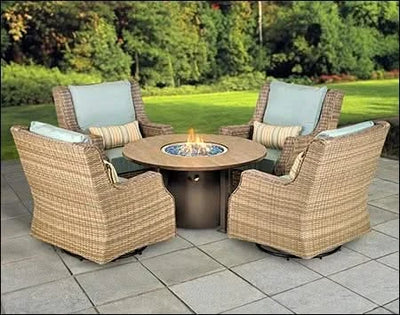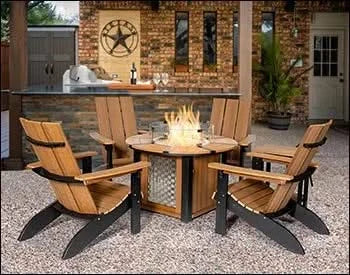Huddling around a warm fire with friends and family during the autumn and winter months is the best destination ever. Whether you’re roasting marshmallows, sharing stories, or simply enjoying the ambiance, a fire feature is the perfect addition to any outdoor space. While fire tables and fire pits offer distinct experiences, they share a fundamental aspect: safety. Both types of fire features require careful handling and adherence to safety guidelines to prevent accidents and injuries.
To ensure a safe and enjoyable experience with either type of fire feature, it’s important to follow safety guidelines. According to Mercury Insurance, maintaining a safe distance of at least 10-25ft feet between your fire pit or fire table and any flammable materials is crucial.
In this article, we’ll explore the key differences between fire tables and fire pits, helping you determine which one is the best fit for your backyard or patio. Let’s dive in and discover the perfect fire feature for your outdoor living space.
What is the difference between a fire pit and a fire table?
Fire pits and fire tables are both popular outdoor features that provide warmth, ambiance, and a place to gather with friends and family. However, there are some key differences between the two. The following chart provides a visual representation of them side by side.

What Is a Fire Pit?
A fire pit is a traditional outdoor feature that is typically dug into the ground. Fire pits can be made of a variety of materials, including stone, metal, or concrete. They are often used for cooking food, roasting marshmallows, or simply enjoying the warmth of the fire.
 Traditional Outdoor Fire Pit
Traditional Outdoor Fire PitKey Features of Fire Pits
- Traditional design: Fire pits have a classic, campfire-like appearance.
- Versatile: Fire pits can be used for a variety of purposes, including cooking, roasting, and simply enjoying the warmth.
- Customizable: Fire pits can be customized to fit your specific needs and preferences.
Common functionalities of a Fire Pit
Fire pits are typically fuelled by wood or charcoal. To use a fire pit, you will need to start a fire and add fuel as needed. Once the fire is going, you can use it to cook food or simply enjoy the warmth.
What are the advantages and disadvantages of a fire pit?
Advantages of a fire pit:
- Authentic outdoor experience: Fire pits offer a traditional, campfire-like atmosphere that is perfect for creating lasting memories with friends and family. This is especially appealing to those who enjoy the nostalgic charm of outdoor gatherings and want to recreate the feeling of a backyard campfire.
- Versatile use: Fire pits can be used for a variety of purposes, such as cooking food, roasting marshmallows, or simply enjoying the warmth and ambiance. This versatility makes them a great choice for people who want a multi-functional outdoor feature.
- Customizable design: Fire pits can be customized to fit your specific needs and preferences. You can choose from a variety of materials, shapes, and sizes to create a fire pit that perfectly complements your outdoor space. This customization option is ideal for those who want a unique and personalized outdoor feature.
- Cost-effective: Fire pits are generally less expensive than fire tables, making them a more affordable option for those on a budget. This is especially beneficial for people who want to enjoy the benefits of a fire feature without breaking the bank.
Disadvantages of a fire pit:
- Requires maintenance: Fire pits require regular maintenance, such as cleaning out ash and debris.
- Safety hazard: Fire pits can be a safety hazard, especially if they are not used properly.
- Produces smoke: Fire pits produce smoke, which can be a nuisance and upset your neighbours.
What Is a Fire Table?
Fire tables are a more modern take on the traditional fire pit. They're elevated platforms with a built-in fire feature, often featuring a sleek, contemporary design. Think of them as a cross between a table and a fireplace.
 Fire Table for out door living space, patio or backyard
Fire Table for out door living space, patio or backyardTop Features of a Fire Table
Fire tables offer a modern and versatile alternative to traditional fire pits. By combining the warmth and ambiance of a fire with the functionality of a table, fire tables address the need for a stylish and practical outdoor heating and gathering space. Their sleek design, built-in safety features, and efficient fuel options make them a popular choice for those seeking a convenient and enjoyable outdoor experience.
- Versatility: Fire tables offer a multi-functional design, combining the warmth and ambiance of a fire with the practicality of a table. You can use them for dining, socializing, or simply enjoying the heat.
- Style: They come in a variety of styles, from rustic to modern, so you can find one that perfectly complements your outdoor decor.
- Safety: Many fire tables have built-in safety features, such as glass windshields or protective screens, to minimize the risk of accidents.
- Efficiency: They often use gas or propane, which provides a cleaner and more efficient burn than wood or charcoal.
How Fire Tables Function
Fire tables are typically powered by propane or natural gas. These fuels are cleaner burning than wood or charcoal, producing less smoke and ash. The gas is piped into the fire table through a concealed line, where it ignites and creates a flame.
Many fire tables feature adjustable flames that allow you to control the intensity of the heat and ambiance. This gives you the flexibility to create a cozy, intimate setting or a more vibrant, energetic atmosphere.
Some fire tables also include safety features such as glass wind glass guards or protective screens to prevent accidental burns or sparks from flying. These features make fire tables a safer option for families with children or pets.
In essence, fire tables offer a convenient and efficient way to enjoy the warmth and ambiance of a fire without the hassle of traditional wood-burning fire pits.
What are the advantages and disadvantages of a Fire Table?
Fire Table Advantages:
- Modern design: Fire tables offer a sleek, contemporary look that can enhance the overall aesthetic of your outdoor space.
- Versatility: They can be used for a variety of purposes, including dining, socializing, and heating.
- Safety: Built-in safety features can help minimize the risk of accidents.
- Efficiency: Gas or propane fuel provides a cleaner and more efficient burn than wood or charcoal.
Fire Table Disadvantages:
- Cost: Fire tables are generally more expensive than traditional fire pits due to their superior materials and construction, additional features, professional installation and maintenance requirements, and brand or style.
- Limited portability: They are often larger and heavier, making them less portable than fire pits.
- Fuel dependency: You'll need access to a gas or propane line or tank.
Ultimately, the choice between a fire pit and a fire table depends on your personal preferences, outdoor space, and budget. If you're seeking a traditional, campfire-like experience and enjoy the versatility of cooking and roasting, a fire pit might be the ideal choice. However, if you prioritize modern aesthetics, convenience, and a multi-functional outdoor space, a fire table could be the better option.
Consider your lifestyle, the ambiance you want to create, and your available space to make the best decision for your outdoor living area.
 Email us at sales@luxyardandhomes.com with your inquiry and a outdoor living expert will be in touch with you
Email us at sales@luxyardandhomes.com with your inquiry and a outdoor living expert will be in touch with you







